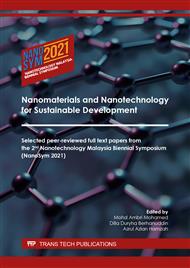p.69
p.77
p.87
p.93
p.105
p.111
p.123
p.137
p.147
The Effect of Temperature and Incubation Period on the Size and Polydispersity Index of the Nano-Emulsion Containing Essential Oil from Cinnamomum zeylanicum
Abstract:
Nanotechnology permits broad advances in agricultural research, such as disease prevention and treatment in plants using various approaches including nano-fungicide. Nano-fungicide has been able to draw much attention due to its higher efficacy even at very low doses because nano-sized particles could be more chemically reactive and bioactive than larger particles. Nano-fungicide is defined as a nanomaterial containing an active ingredient (essential oil etc.) with fungicide action and is incorporated into nano-emulsion. Nano-emulsion is obtained when the size of an emulsion droplet reaches approximately 20-500 nm. The physicochemical properties of nano-emulsions are interesting for practical applications especially in agriculture because of their small droplet size and long-term stability. Previously, a nano-fungicide formulation was developed using the nano-emulsion composition of the detergent Span 80 and Tween 80 and the essential oil extracted from the plant leaves of Cinnamomum zeylanicum (cinnamon) was successful to control the growth of Aspergillus flavus in storage grain corn. In this study, we investigated the effect of temperature at 4°C, 30°C and 60°C on the size and polydispersity index (PDI) of the nano-emulsion droplet at day 1, 30 and 60 of storage. The results of the nano-emulsion droplet size were significantly increased at 60°C after 30 and 60 days of storage and stable from 4 to 30°C even at 60 days of storage. This study provides a strategy to evaluates the effect of environmental factors on the quality of the formulated product, which is utilized for the prediction of its shelf life and determine proper storage conditions. Therefore, the optimized nano-emulsion formulation was characterized by droplet size and PDI for 2 months.
Info:
Periodical:
Pages:
105-109
Citation:
Online since:
March 2022
Authors:
Keywords:
Price:
Сopyright:
© 2022 Trans Tech Publications Ltd. All Rights Reserved
Share:
Citation:


